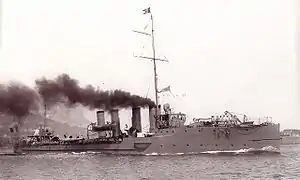French destroyer Dehorter
Dehorter was one of a dozen Bouclier-class destroyers built for the French Navy in the first decade of the 20th century.
 Sister ship Bouclier underway | |
| History | |
|---|---|
| Name | Dehorter |
| Namesake | Pierre Charles Dehorter |
| Builder | Ateliers et Chantiers de Penhoët, Saint-Nazaire |
| Laid down | 1910 |
| Launched | 18 April 1912 |
| Completed | 1913 |
| Stricken | 1933 |
| General characteristics (as built) | |
| Class and type | Bouclier-class destroyer |
| Displacement | 720–756 t (709–744 long tons) |
| Length | 72.3–78.3 m (237 ft 2 in – 256 ft 11 in) (o/a) |
| Beam | 7.6–8 m (24 ft 11 in – 26 ft 3 in) |
| Draft | 2.9–3.3 m (9 ft 6 in – 10 ft 10 in) |
| Installed power |
|
| Propulsion | 2 shafts; 2 steam turbines |
| Speed | 30 knots (56 km/h; 35 mph) |
| Range | 1,200–1,600 nmi (2,200–3,000 km; 1,400–1,800 mi) at 12–14 knots (22–26 km/h; 14–16 mph) |
| Complement | 80–83 |
| Armament |
|
Design and description
The Bouclier class were designed to a general specification and varied significantly from each other in various ways.[1] The ships had an overall length of 74–78.3 meters (242 ft 9 in – 256 ft 11 in), a beam of 7.6–8 meters (24 ft 11 in – 26 ft 3 in), and a draft of 2.9–3.1 meters (9 ft 6 in – 10 ft 2 in). Designed to displace 800 metric tons (787 long tons), they displaced 720–756 t (709–744 long tons) at normal load. Their crew numbered 80–83 men.[1]
The ships were powered by a pair of Parsons steam turbines, each driving one propeller shaft using steam provided by four water-tube boilers. The engines were designed to produce 13,000 shaft horsepower (9,700 kW) which was intended to give the ships a speed of 30 knots (56 km/h; 35 mph). Dehorter only reached 29.3 knots (54.3 km/h; 33.7 mph) during her sea trials. The ships carried enough fuel oil to give them a range of 1,200–1,600 nautical miles (2,200–3,000 km; 1,400–1,800 mi) at cruising speeds of 12–14 knots (22–26 km/h; 14–16 mph).[2]
The primary armament of the Bouclier-class ships consisted of two 100-millimeter (3.9 in) Modèle 1893 guns in single mounts, one each fore and aft of the superstructure, and four 65-millimeter (2.6 in) Modèle 1902 guns distributed amidships. They were also fitted with two twin mounts for 450-millimeter (17.7 in) torpedo tubes amidships.[1]
During World War I, a 45-millimeter (1.8 in) or 75-millimeter (3 in) anti-aircraft gun, two 8-millimeter (0.31 in) machine guns, and eight or ten Guiraud-type depth charges were added to the ships. The extra weight severely overloaded the ships and reduced their operational speed to around 26 knots (48 km/h; 30 mph).[1]
Construction and career
Dehorter was ordered from Ateliers et Chantiers de Penhoët and was launched from its Saint-Nazaire shipyard on 18 April 1912. The ship was completed the following year.[3] When the First World War began in August 1914, Dehorter was the flagship (chef de division) for the Group of Submarines and Destroyers (Flottille de sous-marins et torpilleurs) of the 1st Naval Army (1ère Armée Navale).[4]
References
- Smigielski, p. 203
- Couhat, pp. 101, 104
- Couhat, p. 104
- Prévoteaux, Tome I, p. 30
Bibliography
- Couhat, Jean Labayle (1974). French Warships of World War I. London: Ian Allan. ISBN 0-7110-0445-5.
- Freivogel, Zvonimir (2019). The Great War in the Adriatic Sea 1914–1918. Zagreb: Despot Infinitus. ISBN 978-953-8218-40-8.
- Jordan, John & Caresse, Philippe (2019). French Armoured Cruisers 1887–1932. Barnsley, UK: Seaforth Publishing. ISBN 978-1-5267-4118-9.
- Prévoteaux, Gérard (2017). La marine française dans la Grande guerre: les combattants oubliés: Tome I 1914–1915 [The French Navy during the Great War: The Forgotten Combatants, Book I 1914–1915]. Collection Navires & Histoire des Marines du Mond. Vol. 23. Le Vigen, France: Éditions Lela presse. ISBN 978-2-37468-000-2.
- Prévoteaux, Gérard (2017). La marine française dans la Grande guerre: les combattants oubliés: Tome II 1916–1918 [The French Navy during the Great War: The Forgotten Combatants, Book II 1916–1918]. Collection Navires & Histoire des Marines du Mond. Vol. 27. Le Vigen, France: Éditions Lela presse. ISBN 978-2-37468-001-9.
- Roberts, Stephen S. (2021). French Warships in the Age of Steam 1859–1914: Design, Construction, Careers and Fates. Barnsley, UK: Seaforth Publishing. ISBN 978-1-5267-4533-0.
- Smigielski, Adam (1985). "France". In Gray, Randal (ed.). Conway's All the World's Fighting Ships 1906–1921. Annapolis, Maryland: Naval Institute Press. pp. 190–220. ISBN 0-87021-907-3.